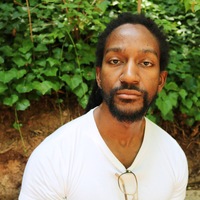Papers by Jared Richardson
Between Doreen Garner’s performance The Observatory and sculpture Black Ocean/Big Black, a signif... more Between Doreen Garner’s performance The Observatory and sculpture Black Ocean/Big Black, a significant divergence in gazes and spaces emerges. On the one hand, The Observatory arguably evokes a metaphorical nexus between body, flesh, organs, and land – a move that integrates archaeological and clinical gazes into a black female optic of pleasure wherein an oppositional gaze disidentifies the theatrical and scopophilic framing of black women’s bodies. The author argues that while Garner’s vitrine-enclosed performances, which elicit several gazes at once, signify a geological position and attempt to exhume the gory archives of black women’s bodies in art and science, her sculptural installation Black Ocean signals a queer liquidation and kinetics of black flesh.
In negotiating the representation of the black female as grotesque within Afrofuturism, spectacle... more In negotiating the representation of the black female as grotesque within Afrofuturism, spectacles in popular culture, such as Kanye West's video, strike an uncanny similarity to images produced by black women artists. The author grapples with such questions and phenomena by examining the respective works of Wangechi Mutu and Shoshanna Weinberger as they relate to black women's grotesqueries in Afrofuturism. Much like Minaj's performance, Mutu and Weinberger simultaneously enjoy and critique aberrations of the "ideal" beauty.
Book Reviews by Jared Richardson
A review of Mark Anthony Neal's text.
Books by Jared Richardson

One/ Sixth , 2016
de stijl | PODIUM FOR ART is proud to present One / Sixth, which features work by the six black a... more de stijl | PODIUM FOR ART is proud to present One / Sixth, which features work by the six black alumni of the University of Texas at Austin’s Masters of Fine Arts program. The fraction one-sixth can imply the measurement of time and space. This seemingly insignificant numeric also gestures toward a noteworthy, fractional state of diversity and inclusion. The exhibition One / Sixth offers a visual tenor that highlights shades, cadences, and durations of temporality writ large. Here, the schism between the myths of linear progress in society and education, and the challenges of cultural exclusion and its attendant circular sense of time has amounted to One / Sixth.
In unique ways, the respective works of these six artists explore time in various media and contexts. Janaye Brown’s “pro-filmic” videos capture and transform mundane phenomena into meditative moments that encourage mindfulness on the viewer’s part, reducing the velocity of modern life and its constant flow of images. Christina Coleman’s sculptures of synthetic hair, which heavily signify race, and Walter Kisner’s collages, which ponder the musical qualities of abstraction, both painstakingly adopt the time- and hand-intensive traditions of craft. Robert Pruitt’s portraits of family and friends evoke Afrofuturism, as they richly borrow material from popular science fiction, comic books, and black revolutionary cultures. Zoë Charlton’s fantastical drawings of racial subjects meld portraits into landscapes, illustrating a variety of alienations, mutations, and voyeurisms that precipitate intersectional identities. Steven Jones’ sculptures have evolved from drawings on maps and mosaic processes, which evoke a measure of time and meditation.
In addition, a printed catalog supplements One / Sixth. Fully illustrated with works from the show, the catalog features critical essays written by cultural critic and doctoral candidate, Jared Richardson.











Uploads
Papers by Jared Richardson
Book Reviews by Jared Richardson
Books by Jared Richardson
In unique ways, the respective works of these six artists explore time in various media and contexts. Janaye Brown’s “pro-filmic” videos capture and transform mundane phenomena into meditative moments that encourage mindfulness on the viewer’s part, reducing the velocity of modern life and its constant flow of images. Christina Coleman’s sculptures of synthetic hair, which heavily signify race, and Walter Kisner’s collages, which ponder the musical qualities of abstraction, both painstakingly adopt the time- and hand-intensive traditions of craft. Robert Pruitt’s portraits of family and friends evoke Afrofuturism, as they richly borrow material from popular science fiction, comic books, and black revolutionary cultures. Zoë Charlton’s fantastical drawings of racial subjects meld portraits into landscapes, illustrating a variety of alienations, mutations, and voyeurisms that precipitate intersectional identities. Steven Jones’ sculptures have evolved from drawings on maps and mosaic processes, which evoke a measure of time and meditation.
In addition, a printed catalog supplements One / Sixth. Fully illustrated with works from the show, the catalog features critical essays written by cultural critic and doctoral candidate, Jared Richardson.
In unique ways, the respective works of these six artists explore time in various media and contexts. Janaye Brown’s “pro-filmic” videos capture and transform mundane phenomena into meditative moments that encourage mindfulness on the viewer’s part, reducing the velocity of modern life and its constant flow of images. Christina Coleman’s sculptures of synthetic hair, which heavily signify race, and Walter Kisner’s collages, which ponder the musical qualities of abstraction, both painstakingly adopt the time- and hand-intensive traditions of craft. Robert Pruitt’s portraits of family and friends evoke Afrofuturism, as they richly borrow material from popular science fiction, comic books, and black revolutionary cultures. Zoë Charlton’s fantastical drawings of racial subjects meld portraits into landscapes, illustrating a variety of alienations, mutations, and voyeurisms that precipitate intersectional identities. Steven Jones’ sculptures have evolved from drawings on maps and mosaic processes, which evoke a measure of time and meditation.
In addition, a printed catalog supplements One / Sixth. Fully illustrated with works from the show, the catalog features critical essays written by cultural critic and doctoral candidate, Jared Richardson.